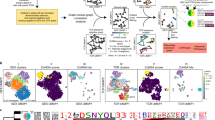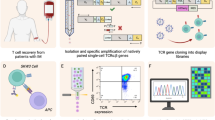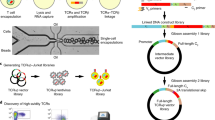Abstract
The immunoglobulin superfamily is a group of proteins, each made of one or several domains sharing key structural features with either the variable (V) or the constant (C) immunoglobulin domains1,2. It includes such functionally important members as the immunoglobulins themselves, major histocompatibility complex (MHC) class I and class II and T-cell receptor (TCR) molecules. Several members of this superfamily are expressed on lymphocytes where they are membrane-bound and capable of interactions with other members of the family, thus taking part in cell–cell recognition. In screening mouse cytolytic-T-cell-derived cDNA libraries, we came across cDNA clones defining a sequence, CTLA-4, which could encode a 223-amino-acid protein clearly belonging to the immunoglobulin superfamily. It consists of one V-like domain flanked by two hydrophobic regions, one of which has a structure suggestive of membrane anchoring. CTLA-4 is mainly expressed in activated lymphocytes and is coinduced with T-cell-mediated cytotoxicity in inducible models of this process. The mouse ctla-4 gene maps to band C of chromosome 1.
This is a preview of subscription content, access via your institution
Access options
Subscribe to this journal
Receive 51 print issues and online access
$199.00 per year
only $3.90 per issue
Buy this article
- Purchase on SpringerLink
- Instant access to full article PDF
Prices may be subject to local taxes which are calculated during checkout
Similar content being viewed by others
References
1. Williams, A. F. & Gagnon, J. Science 216, 696–703 (1982). 2. Hood, L., Kronenberg, M. & Hunkapiller, T. Cell 40, 225–229 (1985). 3. Brunei, J.–F. et al Nature 322, 268–271 (1986). 4. Lobe, C. G., Finlay, B. B., Paranchych, W., Paetkau, V. H. & Bleackley, R. C. Science 232, 858–861 (1986). 5. Gershenfeld, H. K. & Weissman, I. L. Science 232, 854–858 (1986). 6. Conzelmann, A., Corthesy, P., Gianfriglia, M., Silva, A. & Nabholz, M. Nature 298,170–172 (1982). 7. Tse, A. G. D., Barclay, N. A., Watts, A. & Williams, A. F. Science 230, 1003–1008 (1985). 8. He, H.–T., Barbet, J., Chaix, J.–C. & Goridis, C. EMBO J. 5, 2489–2494 (1986). 9. Yarden, Y. et al. Nature 323, 226–232 (1986). 10. Braell, W. A. & Lodish, H. F. Cell 28, 23–31 (1982). 11. Kozak, C. A., Davidson, W. F. & Morse, H. C. Ill Immunogenetics 19, 163–168 (1984). 12. Hibbs, M. L., Hogarth, P. M. & McKenzie, I. F. C. Immunogenetics 22, 335–348 (1985). 13. Holmes, K. L., Palfree, R. G. E., Hammerling, U. & Morse, H. C. Ill Proc. natn. Acad. Sci. U.S.A. 82, 7706–7710 (1985). 14. Lewis, V. A., Koch, T., Plutner, H. & Mellman, I. Nature 324, 372–375 (1986). 15. Hunkapiller, T. & Hood, L. Nature 323, 15–16 (1986). 16. Albert, F., Buferne, M., Boyer, C. & Schmitt–Verhulst, A.–M. Immunogenetics 16, 533–549 (1982). 17. Pierres, A., Schmitt–Verhulst, A.–M., Buferne, M., Golstein, P. & Pierres, M. Scand. J. Immun. 15, 619–625 (1982). 18. Berke, G., Sullivan, K. A. & Amos, B. /. exp. Med. 135, 1334–1350 (1972). 19. Erard, F. et al. J. exp. Med. 160, 584–599 (1984). 20. Pont, S. et al. Eur. J. Immun. 15, 1222–1228 (1985). 21. Hamano, T., Kirn, K. J., Leiserson, W. M. & Asofsky, R. J. Immun. 129, 1403–1406 (1982). 22. Kozak, M. Nucleic Acids Res. 12, 857–871 (1984). 23. Seiki, M., Hattori, S., Harayama, Y. & Yoshida, M. Proc. natn. Acad. Sci. U.S.A. 80, 3618–3622 (1983). 24. Johnson, P. & Wiliams, A. F. Nature 323, 74–76 (1986). 25. Gubler, U. & Hoffman, B. J. Gene 25, 263–269 (1983). 26. Maxam, A. M. & Gilbert, W. Proc. natn. Acad. Sci. U.S.A. 74, 560–564 (1977). 27. Chuvpilov, S. A. & Kravchenko, V. V. FEES Lett. 179, 34–36 (1984). 28. Kyte, J. & Doolittle, R. F. J. molec. Biol. 157, 105–132 (1982). 29. Tourvieille, B., Gorman, S. D., Field, E. H., Hunkapiller, T. & Parnes, J. R. Science 234, 610–614 (1986). 30. Nakauchi, H. et al. Proc. natn. Acad. Sci. U.S.A. 82, 5126–5130 (1985). 31. Arden, B., Klotz, J. L., Siu, G. & Hood, L. E. Nature 316, 783–787 (1985). 32. Hedrick, S. M., Nielsen, E. A., Kovaler, J., Cohen, D. I. & Davis, M. M. Nature 308, 153–158 (1984). 33. Saito, H. et al. Nature 312, 36–40 (1984). 34. Anderson, M. L. M., Szajnert, M. F., Kaplan, J. C., McColl, L. & Young, B. D. Nucleic Acids Res. 12, 6647–6661 (1984). 35. Bothwell, A. L. M. et al Cell 24, 625–637 (1981). 36. Ravetch, J. V. et al. Science 234, 718–724 (1986). 37. Mostov, K. E., Friedlander, M. & Blobel, G. Nature 308, 37–43 (1984). 38. Barthels, D. et al EMBO J. (in the press). 39. Traut, W., Winking, H. & Adolph, S. Cytogenet. Cell Genet. 38, 290–297 (1984). 40. Nesbitt, M. N. & Francke, U. Chromosoma 41, 145–158 (1973). 41. Mattel, M. G. et al. Hum. Genet. 69, 268–271 (1985). 42. Camargo, M. & Cervenka, J. Am. J. hum. Genet. 34, 757–780 (1982).
Author information
Authors and Affiliations
Rights and permissions
About this article
Cite this article
Brunet, JF., Denizot, F., Luciani, MF. et al. A new member of the immunoglobulin superfamily—CTLA-4. Nature 328, 267–270 (1987). https://doi.org/10.1038/328267a0
Received:
Accepted:
Issue Date:
DOI: https://doi.org/10.1038/328267a0



